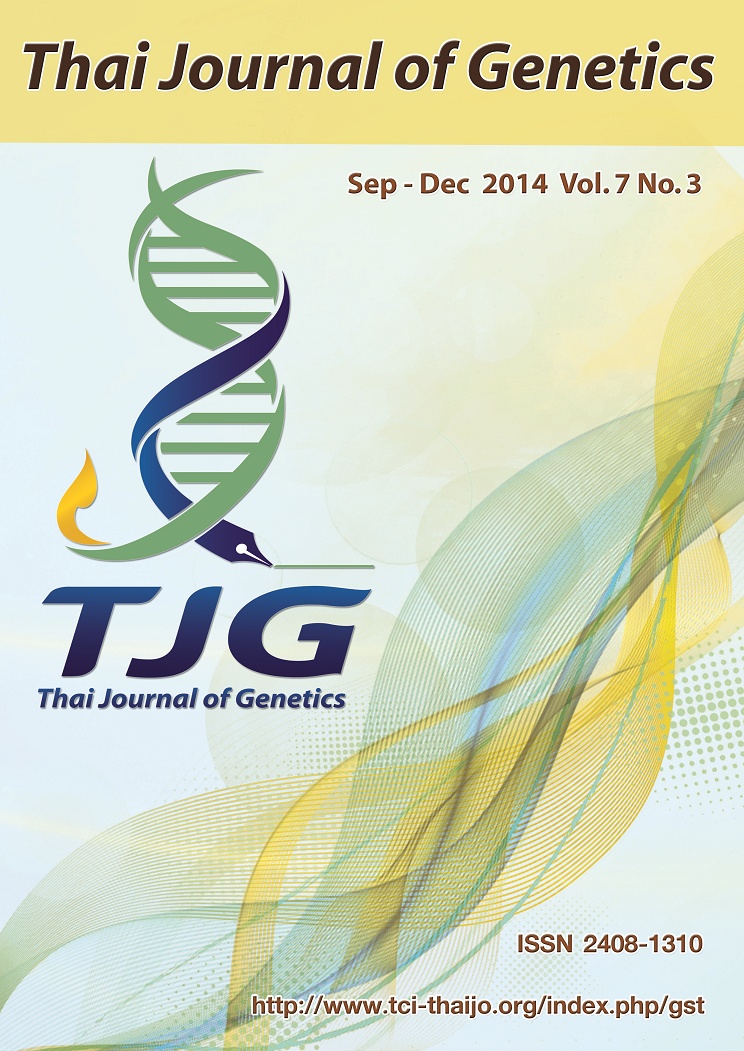Overexpression of OSB2 gene in transgenic rice up-regulated expression of structural genes in anthocyanin biosynthesis pathway
DOI:
https://doi.org/10.14456/tjg.2014.24Keywords:
Anthocyanin biosynthesis, OSB2 gene, Oryza sativa, Transformation, AgrobacteriumAbstract
Anthocyanin biosynthesis is regulated by regulatory genes encoding transcription factors which control expression of several structural genes in the anthocyanin pathway. The OSB2 gene encoding a Myc-type basic-helix-loop-helix (bHLH) transcription factor which regulates anthocyanin biosynthesis was previously cloned from a Thai black rice variety Khum. In this study, the cloned OSB2 gene was transformed into two white rice varieties Nipponbare and Taichung 65 using Agrobacterium to study the regulation of anthocyanin biosynthesis in rice. The semi-quantitative RT-PCR analysis revealed that transgenic rice plants overexpressing the OSB2 gene up-regulated the expression of some structural genes in anthocyanin biosynthesis including early biosynthesis gene (EBG) i.e. F3H (flavanone 3-hydroxylase) and also late biosynthesis genes (LBGs) i.e. DFR (dihydroflavonol 4-reductase) and ANS (anthocyanidin synthase). The present results support the other evidences that the regulatory mechanism of anthocyanin biosynthesis in rice may be different from other plants in which EBGs and LBGs were regulated separately. The results provide the understanding of functions of OSB2 gene in regulation of anthocyanin biosynthesis pathway in rice and will be useful to apply this gene as a marker gene for the improvement of rice varieties.
References
Geekiyanage S, Takase T, Ogura Y, Kiyosue T (2007) Anthocyanin production by over-expression of grape transcription factor gene VlmybA2 in transgenic tobacco and Arabidopsis. Plant Biotech Rep 1: 11–18.
Harborne JB, Williams CA (2000) Advances in flavonoid research since 1992. Phytochemistry 55: 481–504
Hiei Y, Komari T, Kubo T (1997) Transformation of rice mediated by Agrobacterium tumefaciens. Plant Mol Biol 35: 205–218.
Hirose S, Kawahigashi H, Tagiri A, Ohkawa Y (2008) Herbicide-induced anthocyanin accumulation in transgenic rice by expression of rice OSB2 under the control of rice CYP72A21 promoter. J Agric Food Chem 27;56 (4): 1259-63.
Hwang, S.K., Y.M. Kim (2000) A simple and reliable method for preparation of cross-contamination-free plant genome DNA for PCR-based detection of transgenes. J Biochem Mol Biol 33: 537-546.
Inta, P, Phongburaphat W, Pongjareanki S, Chowpongpang S, Sangtong V, Sakulsingharoj C (2013) Cloning and characterization of OSB2 gene controlling anthocyanin biosynthesis in rice. Thai.J.Genet 6 (1): 25-29.
Ithal N, Reddy A R (2004) Rice flavonoid pathway genes, OsDfr and OsAns, are induced by dehydration, high salt and ABA, and contain stress responsive promoter elements that interact with the transcription activator, OsC1-MYB. Plant Sci J 166: 1505–1513.
Jefferson R A (1987) Assaying chimeric genes in plants: the GUS gene fusion system. Plant Mol Biol Rep 5: 387-405.
Kawahigashi H, Hirose S, Iwai T, Ohashi Y, Sakamoto W, Maekaw M, Ohkawa Y (2007) Chemically Induced Expression of Rice OSB2 under the Control of the OsPR1.1 Promoter Confers Increased Anthocyanin Accumulation in Transgenic Rice. J Agric Food Chem 55: 1241-1247.
Lepiniec L, Debeaujon I, Routaboul JM, Baudry A, Pourcel L, Nesi N, Caboche M (2006) Genetics and biochemistry of seed flavonoids. Annu Rev Plant Biol 57: 405–430.
Lim S H, Ha S H (2013) Marker development for the identification of rice seed color. Plant Biotechnol Rep 7: 391–398.
Quattrocchio F, Baudry A, Lepiniec L, Grotewold E (2006) The regulation of favonoid biosynthesis. In: Grotewold E (ed) The Science of Flavonoids. Springer Sciences & Business Media, New York, pp 97–122.
Saika H, Toki S (2010) Mature seed-derived callus of the model indica rice variety Kasalath is highly competent in Agrobacterium-mediated transformation. Plant Cell Rep 29: 1351–1364.
Saitoh K, Onishi K, Mikami I, Thidar K, Sano Y (2004) Allelic Diversification at the C (OsC1) Locus of Wild and Cultivated Rice:Nucleotide Changes Associated With Phenotypes. Genetics Society of America 168: 997–1007.
Sakamoto W, Ohmori T, Kageyama K, Miyazaki C, Saito A, Murata M, Noda K, Maekawa M (2001) The Purple leaf (Pl) Locus of Rice: the Plw Allele has a complex Organization and Includes Two Genes Encoding Basic Hlix-Loop-Helix Proteins Involved in Anthocyanin Biosynthesis. Plant Cell Physiol 42(9): 982-991.
Sakulsingharoj C, Phanlumpak K, Inta P, Pongjaroenkit K, Sangtong V (2014) Transformation of rice (Oryza sativa) cultivar Taichung 65 mediated by Agrobacterium tumefaciens. 25th Biennial Conference of the Asian Association for Biology Education 13-16 October 2014, Living Lab for Sustainability Sciences, University of Malaya, Malaysia .
Schijlen E G, Vos C R, Tunen A J, Bovy A G (2004) Modification of flavonoid biosynthesis in crop plants. Phytochemistry 65: 2631–2648.
Seo WD, Kim JY, Han SI, Ra JE, Lee JH, Song YC, Park MJ, Kang HW, Oh SK, Jang KC (2011) Relationship of radical scavenging activities and anthocyanin contents in the 12 colored rice varieties in Korea. J Korean Soc Appl Biol Chem 54: 693–699
Shen Y, Jin L, Xiao P, Lu Y, Bao JS (2009) Total phenolics, flavonoids, antioxidant capacity in rice grain and their relations to grain color, size and weight. J Cereal Sci 49: 106–111
Shih C H, Chu H, Tang L K, Sakamoto W, Maekawa M, Chu I K, Wang M, Lo C (2008) Functional characterization of key structural genes in rice favonoid biosynthesis. Planta 228: 1043–1054.
Toki S (1997) Rapid and Efficient Agrobacterium-MediatedTransformation in Rice. Plant Mol. Biol. Rep 15(1): 16-21.
Yara A, Otani M, Kusumi K, Matsuda O, Shimada T, Iba K (2001) Production of Transgenic Japonica Rice (Oryza sativa) Cultivar, Taichung 65, by the Agrobacterium - Mediated Method. Plant Biotechnol Rep 18 (4): 305 – 310.



